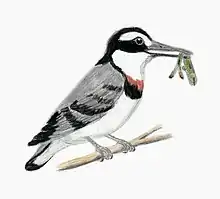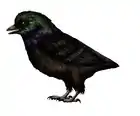| Dromaeosaurines Temporal range: Early Cretaceous-Late Cretaceous ~Likely Tithonian record and Ghost lineage from Kimmeridgian | |
|---|---|
 | |
| Reconstructed skull of Dromaeosaurus | |
| Scientific classification | |
| Domain: | Eukaryota |
| Kingdom: | Animalia |
| Phylum: | Chordata |
| Clade: | Dinosauria |
| Clade: | Saurischia |
| Clade: | Theropoda |
| Family: | †Dromaeosauridae |
| Clade: | †Eudromaeosauria |
| Subfamily: | †Dromaeosaurinae Matthew & Brown 1922 |
| Type species | |
| †Dromaeosaurus albertensis Matthew & Brown 1922 | |
| Genera | |
Dromaeosaurinae is a subfamily of the theropod group Dromaeosauridae. The earliest dromaeosaurine is Utahraptor, dating back to the Early Cretaceous period in North America, however, some isolated teeth seems to represent an indeterminate species of dromaeosaurine, coming from the Late Jurassic period in Africa. If true, this will push their range to the Jurassic period, instead of the Cretaceous, as in most dromaeosaurs.
Most dromaeosaurs are small carnivores, however, dromaeosaurines are represented by some of the largest species (Achillobator, Dakotaraptor, Utahraptor). So far, Dakotaraptor is the only dromaeosaurine with evidence of quill knobs, indicating a plumage; based on this, other members likely had them.
Paleobiogeography
Most dromaeosaurines lived in what is now Asia, North America and possibly Denmark during the Cretaceous period, from the Berriasian to the Maastrichtian stages.[1] However, isolated teeth that may belong to African dromaeosaurines have also been discovered in Ethiopia. These teeth date to the Tithonian stage, of the Late Jurassic period.[2]
Description
Most North American and Asian dromaeosaurines from the Late Cretaceous were generally medium to large-sized animals, with an average length between 1.8 metres (5.9 ft); i. e., Dromaeosaurus and Yurgovuchia.[3] However, among the dromaeosaurines were the largest dromaeosaurs ever, with the feathered Dakotaraptor measuring 5.5 metres (18 ft) long,[4] Achillobator 6 metres (20 ft),[5][3] and Utahraptor up to 7 metres (23 ft).[6]
Dromaeosaurines were a group of eudromaeosaurs that can be recognised in having stouter, box-shaped skulls, as opposed to the other subfamilies, which generally have narrower snouts, also, dromaeosaurines are generally more heavily built than the other members of their family, with thick, heavy-set legs, which were designed more for strength, rather than for speed. They differ from velociraptorines, in having a low DSDI ratio; i. e., their teeth have equal-sized serrations, on both the posterior and on the anterior edges. By contrast, velociraptorines often have larger serrations on the posterior side of the tooth, than the anterior, or no serrations on the anterior side at all.[1][3]
According to Turner et al. 2012, technical diagnoses for dromaeosaurines can be established based on the following traits: fully serrated teeth; vertically oriented pubis; pubic boot (or end) projecting anteriorly and posteriorly; the jugal process of the maxilla, in a ventral view to the external antorbital fenestra, is dorsoventrally wide.[1]
Classification
The Dromaeosaurinae was first erected in 1922 by Matthew and Brown as a part of the "Deinodontidae" (now named Tyrannosauridae).[7] It is defined as a monophyletic group including Dromaeosaurus and all the other dromaeosaurs closer to it than to Velociraptor, Microraptor, Passer and Unenlagia.[1]
Cladogram (2012):
| Dromaeosauridae |
| |||||||||||||||||||||||||||||||||||||||||||||||||||||||||||||||||||||||||||
The exact consensus for the Dromaeosaurinae phylogeny is still uncertain, since most performed phylogenetic analyses have radically different results with some taxa being recovered on different clades or excluded. According to the phylogenetic analysis performed by Senter et al. 2012, Yurgovuchia represents an advanced dromaeosaurine, closely related to Achillobator, Dromaeosaurus and Utahraptor.[8]
During the description of Dakotaraptor in 2015, it was proposed a new cladistic analysis using data from the Theropod Working Group; below are the results for this analysys:[4]
| Eudromaeosauria |
| ||||||||||||||||||||||||||||||||||||||||||
However, in the most recent analysis conducted by Currie and Evans in 2019, the most representative members of the Dromaeosaurinae were recovered as velociraptorines, such as Achillobator and Utahraptor.[9]
| Eudromaeosauria |
| |||||||||||||||||||||||||||||||||||||||||||||||||||||||||||||||||||||||||||||||||
See also
References
- 1 2 3 4 Turner, A.H.; Makovicky, P.J.; Norell, M.A. (2012). "A Review of Dromaeosaurid Systematics and Paravian Phylogeny". Bulletin of the American Museum of Natural History. 2012 (371): 1–206. doi:10.1206/748.1. hdl:2246/6352. S2CID 83572446.
- ↑ Goodwin, M. B.; Clemens, W. A.; Hutchison, J. H.; Wood, C. B.; Zavada, M. S.; Kemp, A.; Duffin, C. J.; Schaff, C. R. (1999). "Mesozoic continental vertebrates with associated palynostratigraphic dates from the northwestern Ethiopian plateau". Journal of Vertebrate Paleontology. 19 (4): 728–741. doi:10.1080/02724634.1999.10011185.
- 1 2 3 Holtz, T.R.; Rey, L.V. (2007). Dinosaurs: The Most Complete, Up-to-Date Encyclopedia for Dinosaur Lovers of All Ages. Random House. ISBN 9780375824197. Genus List for Holtz 2012 Weight Information
- 1 2 DePalma, R. A.; Burnham, D. A.; Martin, L. D.; Larson, P. L.; Bakker, R. T. (2015). "The First Giant Raptor (Theropoda: Dromaeosauridae) from the Hell Creek Formation". Paleontological Contributions (14). doi:10.17161/paleo.1808.18764.
- ↑ Perle, A.; Norell, M.A.; Clark, J. (1999). "A new maniraptoran Theropod−Achillobator giganticus (Dromaeosauridae)−from the Upper Cretaceous of Burkhant, Mongolia". Contributions from the Geology and Mineralogy Chair, National Museum of Mongolia (101): 1–105. OCLC 69865262.
- ↑ Kirkland, J. I.; Burge, D.; Gaston, R. (1993). "A large dromaeosaurid (Theropoda) from the Lower Cretaceous of Eastern Utah". Hunteria. 2 (10): 1–16.
- ↑ Matthew, W. D.; Brown, B. (1922). "The family Deinodontidae, with notice of a new genus from the Cretaceous of Alberta". Bulletin of the American Museum of Natural History. 46: 367–385. hdl:2246/1300.
- ↑ Senter, P.; Kirkland, J. I.; Deblieux, D. D.; Madsen, S.; Toth, N. (2012). "New Dromaeosaurids (Dinosauria: Theropoda) from the Lower Cretaceous of Utah, and the Evolution of the Dromaeosaurid Tail". PLOS ONE. 7 (5): e36790. Bibcode:2012PLoSO...736790S. doi:10.1371/journal.pone.0036790. PMC 3352940. PMID 22615813.
- ↑ Currie, P. J.; Evans, D. C. (2020). "Cranial Anatomy of New Specimens of Saurornitholestes langstoni (Dinosauria, Theropoda, Dromaeosauridae) from the Dinosaur Park Formation (Campanian) of Alberta". The Anatomical Record. 303 (4): 691–715. doi:10.1002/ar.24241. PMID 31497925. S2CID 202002676.
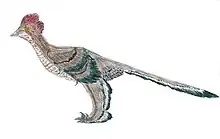



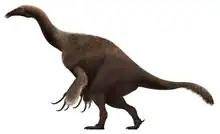

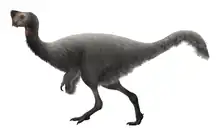
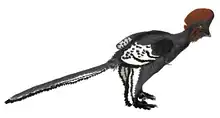


.png.webp)

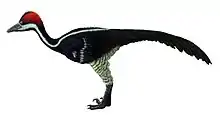
.jpg.webp)

